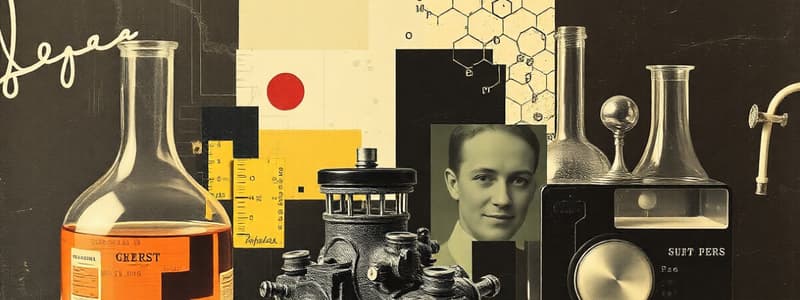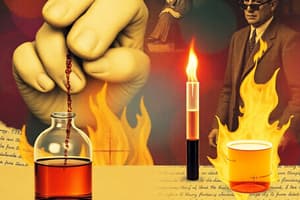Podcast
Questions and Answers
What is the primary source of free energy for ATP synthesis?
What is the primary source of free energy for ATP synthesis?
- Light energy from the sun
- The breakdown of complex molecules in food (correct)
- Energy stored within the ATP molecule
- Direct phosphorylation from inorganic phosphate
What role do enzymes play in metabolic reactions?
What role do enzymes play in metabolic reactions?
- They increase the overall energy of activation required.
- They are consumed in the reactions they catalyze.
- They lower the activation energy barrier for reactions. (correct)
- They convert reactants into products without changing their structure.
How do enzymes achieve the reduction of activation energy?
How do enzymes achieve the reduction of activation energy?
- By removing substrates from the reaction.
- By bringing substrate molecules together. (correct)
- By changing the pH of the surrounding solution.
- By increasing the temperature of the reaction.
In which stage of aerobic cellular respiration does substrate-level phosphorylation primarily occur?
In which stage of aerobic cellular respiration does substrate-level phosphorylation primarily occur?
What is the role of NAD+ in cellular respiration?
What is the role of NAD+ in cellular respiration?
What is the final product formed when oxygen acts as the final electron acceptor in oxidative phosphorylation?
What is the final product formed when oxygen acts as the final electron acceptor in oxidative phosphorylation?
What mechanism describes the interaction between enzyme and substrate that involves a change in the substrate's shape?
What mechanism describes the interaction between enzyme and substrate that involves a change in the substrate's shape?
Which of the following statements about oxidative phosphorylation is FALSE?
Which of the following statements about oxidative phosphorylation is FALSE?
Which is NOT a source of free energy used for ATP synthesis?
Which is NOT a source of free energy used for ATP synthesis?
What type of phosphorylation is involved in transferring a phosphate group from PEP to ADP?
What type of phosphorylation is involved in transferring a phosphate group from PEP to ADP?
What best describes the process of an exergonic reaction?
What best describes the process of an exergonic reaction?
In the context of cellular respiration, which statement is true about the role of electrons?
In the context of cellular respiration, which statement is true about the role of electrons?
Which of the following correctly defines entropy in a chemical reaction?
Which of the following correctly defines entropy in a chemical reaction?
Why is ATP considered the universal energy currency in living organisms?
Why is ATP considered the universal energy currency in living organisms?
What characterizes an endergonic reaction?
What characterizes an endergonic reaction?
How do cells generate ATP according to the content provided?
How do cells generate ATP according to the content provided?
Which pathway involves the release of energy through the breakdown of complex molecules?
Which pathway involves the release of energy through the breakdown of complex molecules?
What is a key characteristic of an endothermic reaction?
What is a key characteristic of an endothermic reaction?
During aerobic cellular respiration, which of the following reactions is primarily responsible for the ATP synthesis?
During aerobic cellular respiration, which of the following reactions is primarily responsible for the ATP synthesis?
Which component of ATP is primarily responsible for its high energy content?
Which component of ATP is primarily responsible for its high energy content?
Flashcards
Exothermic Reaction
Exothermic Reaction
A chemical reaction that releases energy, resulting in products with less chemical potential energy than the reactants.
Endothermic Reaction
Endothermic Reaction
A chemical reaction that absorbs energy, resulting in products with more chemical potential energy than the reactants.
Gibbs Free Energy
Gibbs Free Energy
The energy available to do useful work in a system.
Exergonic Reaction
Exergonic Reaction
Signup and view all the flashcards
Endergonic Reaction
Endergonic Reaction
Signup and view all the flashcards
Energy Coupling
Energy Coupling
Signup and view all the flashcards
Catabolic Pathway
Catabolic Pathway
Signup and view all the flashcards
Anabolic Pathway
Anabolic Pathway
Signup and view all the flashcards
ATP (Adenosine Triphosphate)
ATP (Adenosine Triphosphate)
Signup and view all the flashcards
Phosphorylation
Phosphorylation
Signup and view all the flashcards
Catabolism
Catabolism
Signup and view all the flashcards
Activation Energy
Activation Energy
Signup and view all the flashcards
Enzymes
Enzymes
Signup and view all the flashcards
Active Site
Active Site
Signup and view all the flashcards
Substrate
Substrate
Signup and view all the flashcards
Induced-fit Model
Induced-fit Model
Signup and view all the flashcards
Substrate-level Phosphorylation
Substrate-level Phosphorylation
Signup and view all the flashcards
Oxidative Phosphorylation
Oxidative Phosphorylation
Signup and view all the flashcards
NAD+ and FAD2+
NAD+ and FAD2+
Signup and view all the flashcards
Study Notes
Entropy Increase in Chemical Reactions
- Entropy increases when solids react to form liquids or gases.
- Entropy increases when liquids react to form gaseous products.
- Entropy increases when the total number of product molecules is greater than the total number of reactant molecules.
Exothermic Reactions
- Exothermic reactions release energy, resulting in products with less chemical potential energy than reactants.
Endothermic Reactions
- Endothermic reactions absorb energy, resulting in products with more chemical potential energy than reactants.
Gibbs Free Energy
- Gibbs free energy represents the energy available to do useful work.
- Gibbs free energy drives chemical and physical work in the body.
- Change in free energy (ΔG) is calculated as: ΔG = Gfinal - Ginitial
Exergonic Reactions
- Exergonic reactions release free energy (ΔG is negative).
- Products have less free energy than reactants.
- Free energy released drives spontaneous reactions.
Endergonic Reactions
- Endergonic reactions absorb free energy (ΔG is positive).
- Products have more free energy than reactants.
- Endergonic reactions require energy input to occur.
- Cells couple endergonic reactions with exergonic reactions to make them proceed.
- Energy coupling is the transfer of energy from one reaction to another.
Catabolic Pathways
- Catabolic pathways release energy and break down complex molecules into simpler molecules.
Anabolic Pathways
- Anabolic pathways use energy to build complex molecules from simpler molecules.
Aerobic Cellular Respiration
- Aerobic cellular respiration occurs in the presence of oxygen.
- It's a series of redox reactions.
- Glucose is oxidized (loses electrons) to form carbon dioxide.
- Oxygen is reduced (gains electrons) to form water.
- The movement of electrons is important for ATP formation.
- The three main goals are:
- Break down the bonds in glucose to form carbon dioxide
- Transfer hydrogen atom electrons from glucose to oxygen to form water
- Capture released energy to form ATP
- Normally, glucose breakdown leads to heat/light energy but the body traps the energy and stores it as ATP.
Adenosine Triphosphate (ATP)
- ATP is composed of:
- Adenine (nitrogenous base)
- Ribose (5-carbon sugar)
- Three phosphate groups
- ATP stores and releases free energy due to the negatively charged phosphate groups.
- ATP supplies energy directly in all cells.
- It's the universal energy currency in living organisms.
- Provides sufficient energy
- Couples to various reactions
- Assembled using energy from a variety of food molecules
- Assembly and access is immediate
- ATP can drive endergonic reactions through phosphorylation.
- Phosphorylation: The phosphate group transfers from ATP to a reactant molecule.
- ATP is formed from ADP + Pi.
- ATP synthesis requires the addition of free energy.
- The necessary energy often comes from complex molecules in food (carbohydrates, fats, proteins).
Enzymes and Activation Energy
- Enzymes lower the activation energy needed for reactions to happen.
- Without enzymes, metabolic reactions would be extremely slow.
- Even exergonic reactions require activation energy.
- Reaction rate depends on the number of reactant molecules overcoming the activation barrier.
- Enzymes increase the reaction rate by lowering the activation energy to reach the transition state.
- ΔG remains unchanged.
- Mechanisms for reducing activation energy:
- Bringing substrate molecules together
- Exposing substrates to altered charged environments
- Changing substrate shape (induced-fit model)
Four Main Stages of Aerobic Respiration
-
Glycolysis
-
Pyruvate Oxidation
-
Krebs Cycle (Citric Acid, TCA)
-
Oxidative Phosphorylation
-
Each stage involves energy transfer by:
- Substrate-level phosphorylation
- Oxidative phosphorylation
Substrate-Level Phosphorylation
- Forms ATP through enzyme-catalyzed reactions.
- Transfers a phosphate group from a molecule (e.g., PEP) directly to ADP to form ATP.
- A small amount of ATP is made this way from one glucose molecule.
Oxidative Phosphorylation
- Forms ATP indirectly from a series of redox reactions in the mitochondria.
- Uses two coenzymes for electron transfer (NAD+ and FAD2+).
- NAD+ is reduced to NADH + H+ (carries two electrons and one proton).
- FAD2+ is reduced to FADH2.
- NAD+ and FAD2+ remove hydrogen atoms (and thus electrons) from glucose and pass them down a series of electron acceptors.
- NAD+ and FAD2+ are reduced at different points and multiple times.
- Oxygen is the final electron acceptor (forming water).
Studying That Suits You
Use AI to generate personalized quizzes and flashcards to suit your learning preferences.




